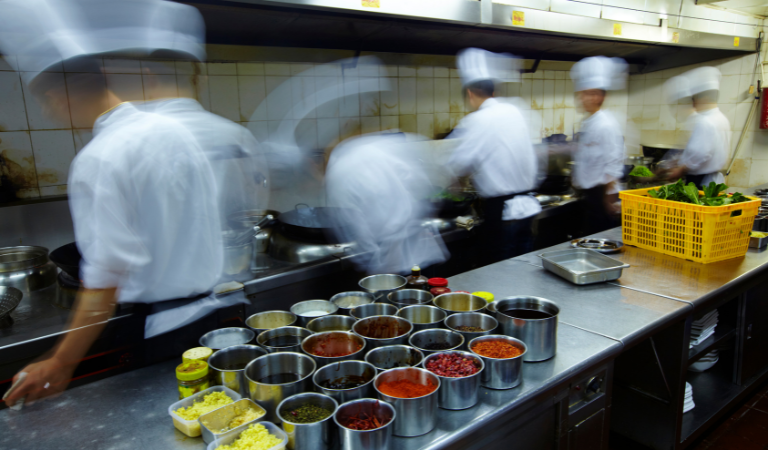Inflation, characterized by the sustained increase in the general price levels of goods and services, leads to a decrease in the purchasing power of a currency and has far-reaching effects on businesses, consumers, and the overall economy. It impacts production costs, consumer spending, and investment decisions. It is a critical factor in monitoring and managing businesses across all sectors.
For the foodservice industry, inflation presents unique challenges and opportunities. This article explores the impact of inflation on the foodservice sector, examining how rising prices affect businesses and providing insights into strategies for success in a demanding economic climate. As industry professionals, understanding and adapting to these inflationary pressures is key to maintaining profitability and fostering growth in an ever-changing landscape.
The State Of Inflation In The U.S.
As we delve into the profound impact of inflation on the food industry, it's crucial to first examine the current state of inflation in the United States. Recent data from the U.S. Bureau of Labor Statistics paints a revealing picture of the nation's inflation trajectory. In April 2023, the Consumer Price Index (CPI) rose by 4.9%, marking the smallest increase in two years. This reading represents a notable slowdown from previous months and is the smallest annual reading since April 2021.
In a significant trend, inflation readings have weakened for ten consecutive months, beginning their descent from the peak observed in June 2022 when the CPI stood at a striking 9.1%. The index further declined from 5% in March, illustrating a consistent pattern of decreasing inflation rates. It's essential to note that while this means consumers haven't witnessed falling prices in a broad sense, the rate at which prices are rising has notably decelerated. Policymakers, guided by the goal of maintaining inflation at around 2% annually, anticipate that it may take another year or more to attain this target.
Historical Context Of Inflation
To contextualize these numbers, it's imperative to reflect on the historical trajectory of inflation in the United States. For decades, the country experienced relatively mild inflation. However, this prevailing trend took a notable turn in early 2021 as the U.S. economy emerged from the pandemic-related shutdown. A surge in pent-up demand for dining out, entertainment, and vacations, fueled by accumulated savings from government relief programs, initiated a rapid rise in consumer prices. Concurrently, the global economy grappled with supply chain disruptions, exacerbated by Russia's invasion of Ukraine. In essence, supply chains struggled to keep pace with the voracious consumer spending appetite.
As the economy reopened following the pandemic, businesses raced to hire workers, leading to record-high job openings. This shift in the labor market in favor of workers, who were presented with ample opportunities, translated into wages growing at their fastest pace in decades. In response, employers, especially labor-intensive service businesses, adjusted by raising their prices. The result is a landscape where inflation is increasingly tied to labor market dynamics, reshaping the economic backdrop in which the food industry operates.

How Inflation Impacts The Foodservice Industry
Inflation takes a toll on various aspects of the foodservice industry, from raw materials to labor costs to consumer spending, all of which can seriously impact the profitability and growth of businesses within the sector.
Rising Costs Of Raw Materials
Inflation's impact on the foodservice industry is unmistakable, notably escalating raw material costs. In August 2023, the United Nations Food and Agriculture Organization's (FAO) World Price Index, which tracks global food commodity prices, registered a decline, averaging 121.4 points, down from the revised figure of 124.0 the previous month. This decline encompassed various essential food categories, including dairy products, vegetable oils, meat, and cereals. However, it's important to note that amidst this decline, the FAO's rice benchmark surged to a 15-year-high, primarily due to Indian export restrictions. These fluctuations underscore the intricate landscape that businesses must navigate.
For companies in the food industry, the challenge lies in managing these cost increases while striving to maintain price competitiveness. Factors like supply chain disruptions triggered by global events and extreme droughts in the Western United States have further exacerbated the situation, driving up food prices and constraining the availability of critical ingredients. Despite occasional fluctuations in raw material costs, many major corporations, including industry leaders like PepsiCo, have indicated their intent to continue raising prices or sustain them at elevated levels in the foreseeable future. This strategic stance reflects the need to strike a delicate balance between managing costs and safeguarding profitability, all while delivering value to customers in an inflation-affected landscape.
Labor Costs
Inflation's pervasive impact extends to labor costs, an integral component of the operational expenses incurred by businesses. As the general price level escalates, minimum wage rates may rise in an effort to preserve the real value of workers' earnings. This presents an added layer of complexity for operators, as labor costs represent a significant portion of their financial outlays. Balancing the need to fairly compensate employees with the imperative of managing overall expenses becomes a delicate juggling act. Consequently, establishments must implement innovative strategies to optimize staffing levels, streamline operations, and remain competitive in the face of these mounting labor costs.
Impact On Consumer Spending
The ripple effects of inflation reach beyond the confines of the industry's balance sheets and touch the heart of its customer base. As inflation erodes consumer purchasing power, disposable income dwindles, prompting individuals to exercise greater fiscal restraint. In the context of the foodservice industry, this translates into a decline in consumer spending. The prospect of dining out or ordering takeout, once a routine indulgence, becomes a less frequent occurrence as consumers tighten their belts. This shift in consumer behavior directly impacts the revenue streams of restaurants, cafés, and other establishments. In response, businesses in this sector must innovate and adapt their offerings to cater to evolving consumer preferences and budget constraints.

Citable Statistics
To appreciate the full extent of inflation's impact, it is essential to consider industry-specific data and trends.
Industry-Specific Inflation Rates
The latest data from the Bureau of Labor Statistics' Consumer Price Index underscores the significant inflationary pressures confronting the foodservice industry. Notably, the prices for dining out have experienced a notable surge, registering an impressive year-over-year increase of 8.8%, accompanied by a monthly increment of 0.6%. This surge in food-away-from-home prices is the third most substantial contributor to monthly inflation, trailing only behind the increases seen in transportation services (up 13.9%) and electricity (up 10.2%).
Limited-service and full-service dining establishments contend with substantial price escalations, with limited-service menu prices witnessing a 7.9% year-over-year increase, while full-service restaurant prices have surged by 8% compared to March 2022. This shift in pricing dynamics marks a noteworthy development, as it is the first instance in over a year when restaurant prices have outpaced those of groceries.
Price Increases In Key Commodities
The food industry grapples with inflation's impact as key commodities witness significant price hikes. The FAO grain price index recently rose by 1%, primarily driven by a notable 7% surge in international corn prices. This surge is attributed to strong demand from Brazil, reduced sales by Argentine farmers, and increased barge shipping rates due to the lowering of the Mississippi River levees. Simultaneously, the Sugar Price Index has surged by 9.8% since August, reaching its highest level since November 2010, amid mounting concerns over a tighter global supply outlook in the coming season. International beef prices have also increased, driven by strong demand for imported lean meat, especially in the United States. These price increases in essential commodities present significant challenges for the food industry, affecting cost structures and pricing strategies across the sector.
Consumer Spending Data
Amidst the challenges posed by inflation, consumer spending trends in the food industry reveal intriguing shifts in dining preferences and habits. Sales at food services and drinking places, a critical gauge of household finances, surged by 1.4%, following a 0.8% increase in June, highlighting the importance of dining out as an economic indicator. A recent survey conducted by US Foods® on a sample of over 1,000 Americans offers valuable insights into 2023 dining behavior. Since the onset of the COVID-19 pandemic, takeout and delivery have continued to outpace dine-in occasions, with Americans now opting for takeout or delivery 4.5 times per month on average, compared to dining at a restaurant approximately 3 times a month. Convenience, socialization, and the desire to avoid cooking at home remain the driving factors for dining out. Preferences in restaurant types range from casual dining to fast food, fast-casual, contemporary casual, and bar and grills.
On the spending front, approximately half of Americans spend less than $20 per person when dining out, with an average monthly dining expenditure of around $166 per person. Tipping practices vary, with some adhering to the traditional 15% tip and others recognizing exceptional service with a 20% or higher gratuity. These insights illuminate how inflation is shaping consumer choices and expenditures in the food industry.
Adaptive Strategies For Businesses
As the food industry grapples with the formidable challenge of inflation, businesses are adopting strategies to weather the storm, maintain profitability, and continue providing value to their customers. Here are some key strategies that businesses are implementing:
Streamlining Operations
To combat the escalating costs brought on by inflation, establishments are turning to operational optimization as a crucial strategy. This approach encompasses multifaceted efforts aimed at enhancing efficiency and cost-effectiveness. Key tactics involve cross-training staff to fulfill various roles and fostering adaptability during labor shortages and rising costs. Stringent inventory control practices are integral to minimizing waste and maximizing ingredient efficiency, with inventory management software for precise tracking and reorder management. Furthermore, the adoption of restaurant management software automates vital tasks like order processing, inventory management, and staff scheduling, providing a streamlined operational framework to navigate the challenges posed by inflation while maintaining competitiveness in the food industry.
Menu Engineering
Analyzing and adapting menu offerings is another critical strategy operators employ to mitigate the impact of inflation. Menu engineering involves a meticulous examination of menu items to strike a balance between cost-effectiveness and maintaining quality. Restaurants can strategically showcase more cost-effective ingredients without compromising taste or customer satisfaction. Additionally, businesses can reevaluate their menus, focusing on higher-margin items and adjusting portion sizes to manage rising costs while delivering value to patrons. This thoughtful approach to menu design allows establishments to remain competitive, even as ingredient prices fluctuate.
Bulk Purchasing & Procurement Strategies
Bulk purchasing of essential ingredients ensures a steady supply and helps lock in prices, providing some insulation from the market's volatility. Collaborate with other restaurants in your area to pool your purchasing power and negotiate bulk discounts with suppliers. Another strategy would be to look for new suppliers or distributors who may offer competitive pricing. Diversifying your supplier base can provide leverage in negotiations.

Long-Term Planning
In the face of persistent inflationary pressures, businesses adopt forward-thinking strategies to safeguard their financial stability and ensure long-term viability. Long-term planning is emerging as a crucial facet of their response, encompassing the following key considerations:
Hedging Against Future Price Hikes
One proactive approach to mitigating the impact of potential future price increases is to explore financial instruments such as commodity futures. Businesses can hedge against the volatility of essential ingredient prices by strategically investing in these instruments. This financial foresight allows them to lock in favorable rates, thus ensuring a degree of price stability even in the midst of market fluctuations. The judicious use of hedging mechanisms can be a potent tool for managing risks associated with inflation, allowing establishments to maintain cost-effective operations over the long term.
Contract Negotiation Techniques
Establishing robust relationships with suppliers is beneficial for immediate procurement needs and plays a pivotal role in long-term planning. Open and transparent communication with suppliers can lead to mutually advantageous contract negotiations. Businesses can secure favorable terms by fostering trust and collaboration, including stable pricing and extended payment periods. Maintaining long-term, predictable relationships with suppliers is a strategic asset in the arsenal of foodservice businesses, ensuring reliable access to essential ingredients while mitigating the impact of inflationary pressures.
Sustainability As A Cost-Saving Strategy
Sustainability practices have transcended the realm of environmental responsibility to become a powerful cost-saving strategy for establishments. Implementing sustainability initiatives, such as reducing food waste, conserving energy, and sourcing locally, aligns with environmentally-conscious consumers and yields long-term financial benefits. Businesses can lower their operational costs over time by reducing waste and optimizing resource usage. For instance, energy-efficient equipment minimizes utility expenses and extends the lifespan of assets, delivering long-term value. Sourcing locally can enhance supply chain resilience and reduce transportation costs, further contributing to sustainable long-term planning.
Challenges & Opportunities
Inflation has presented the food industry with significant challenges, from rising raw material and labor costs to shifts in consumer spending patterns. However, for businesses that adapt and innovate using the abovementioned strategies, there are opportunities for growth and success in this challenging economic environment.
In this dynamic landscape, where inflation is an enduring reality, businesses must remain proactive and strategic. They can embrace adaptive measures, cultivate strong supplier relationships, and prioritize sustainability to not only weather the storm of inflation but also thrive and provide exceptional value to their customers.
The food industry's ability to evolve and endure in the face of inflation reflects its resilience and adaptability. By staying informed, implementing strategic solutions, and planning for the long term, businesses can navigate the complexities of inflation and emerge stronger, ready to seize new opportunities for sustainable growth.
Additional Resources
For further information and tools to help navigate the impact of inflation on the foodservice industry, please consult the following resources:








